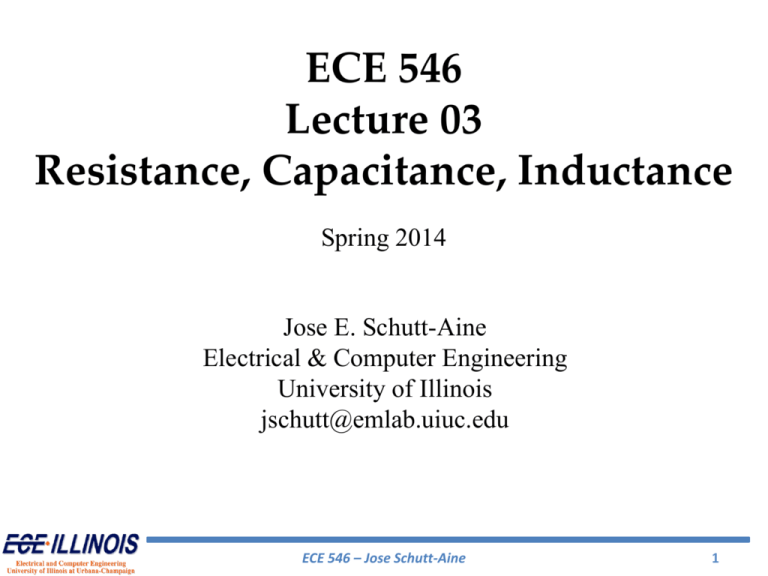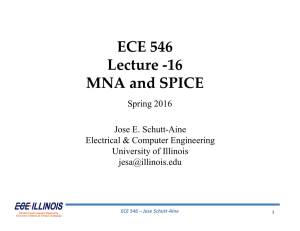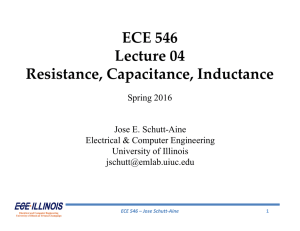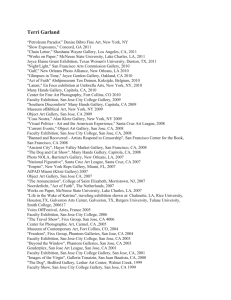Lecture 03
advertisement

ECE 546 Lecture 03 Resistance, Capacitance, Inductance Spring 2014 Jose E. Schutt-Aine Electrical & Computer Engineering University of Illinois jschutt@emlab.uiuc.edu ECE 546 – Jose Schutt-Aine 1 What is Extraction? . - + - + - - - + + + + - - + Process in which a complex arrangement of conductors and dielectric is converted into a netlist of elements in a form that is amenable to circuit simulation. Need Field Solvers ECE 546 – Jose Schutt-Aine 2 Electromagnetic Modeling Tools We need electromagnetic modeling tools to analyze: Transmission line propagation Reflections from discontinuities Crosstalk between interconnects Simultaneous switching noise So we can provide: Improved design of interconnects Robust design guidelines Faster, more cost effective design cycles ECE 546 – Jose Schutt-Aine 3 Field Solvers – History 1960s Conformal mapping techniques Finite difference methods (2-D Laplace eq.) Variational methods 1970s Boundary element method Finite element method (2-D) Partial element equivalent circuit (3-D) 1980s Time domain methods (3-D) Finite element method (3-D) Moment method (3-D) rPEEC method (3-D) 1990s Adapting methods to parallel computers Including methods in CAD tools ECE 546 – Jose Schutt-Aine 4 Categories of Field Solvers • Method of Moments (MOM) • Application to 2-D Interconnects • Closed-Form Green’s Function • Full-Wave and FDTD • Parallel FDTD • Applications ECE 546 – Jose Schutt-Aine 5 Capacitance Relation: Q = Cv Q: charge stored by capacitor C: capacitance v: voltage across capacitor i: current into capacitor dv dQ i (t ) C dt dt 1 t v(t ) i ( )d C 0 ECE 546 – Jose Schutt-Aine 6 Capacitance A : area oA C= d o : permittivity For more complex capacitance geometries, need to use numerical methods ECE 546 – Jose Schutt-Aine 7 Capacitance Calculation (r ) g (r , r ') (r ')dr ' (r ) potential (known) g (r , r ') Green ' s function (known) (r ') charge distribution (unknown) Once the charge distribution is known, the total charge Q can be determined. If the potential =V, we have Q=CV To determine the charge distribution, use the moment method ECE 546 – Jose Schutt-Aine 8 METHOD OF MOMENTS Operator equation L(f) = g L = integral or differential operator f = unknown function g = known function Expand unknown function f f nf n n ECE 546 – Jose Schutt-Aine 9 METHOD OF MOMENTS in terms of basis functions fn, with unknown coefficients to get n L (f n n )g n Finally, take the scalar or inner product with testing of weighting functions wm: n wm , Lf n wm , g n Matrix equation lmn n g m ECE 546 – Jose Schutt-Aine 10 METHOD OF MOMENTS w1 , Lf1 lmn w2 , Lf1 .......... 1 n 2 . w1 , Lf 2 w2 , Lf 2 ............. ... ... ... w1 , g g m w2 , g . Solution for weight coefficients 1 l n nm g m ECE 546 – Jose Schutt-Aine 11 Moment Method Solution D E x ', y ', z ' x, y, z dx ' dy ' dz ' 4 R R 2 L x x ' y y ' z z ' 2 2 2 Green’s function G: LG = d ECE 546 – Jose Schutt-Aine 12 Basis Functions Subdomain bases 1 xn x xn P xn 2 2 1 otherwise xn x2 x1 xn x xn 1 x T xn 2 2 0 otherwise x1 xn x2 Testing functions often (not always) chosen same as basis function. ECE 546 – Jose Schutt-Aine 13 Conducting Plate x ', y ', z ' x, y, z dx ' dy ' 4 R a a a a = charge density on plate ECE 546 – Jose Schutt-Aine 14 Conducting Plate Setting = V on plate R a V x x ' y y ' 2 a x ', y ', z ' a dx ' dy ' a 2 4 x x ' y y ' 2 for |x| < a; |y| < a a Capacitance of plate: 2 a q 1 C dx ' dy ' x ', y ', z ' V V a a ECE 546 – Jose Schutt-Aine 15 Conducting Plate Basis function Pn 1 Pn xm , yn 1 0 s s xm x xm 2 2 s s yn y yn 2 2 otherwise Representation of unknown charge N x, y n f n n 1 ECE 546 – Jose Schutt-Aine 16 Conducting Plate Matrix equation: N V lmn f n n 1 Matrix element: lmn dx ' dy ' xm yn 1 4 xm x ' yn x ' 2 2 1 N 1 C n sn lmn sn V n1 mn ECE 546 – Jose Schutt-Aine 17 Parallel Plates Using N unknowns per plate, we get 2N 2N matrix equation: [l tt ] [l tb ] [l] bt bb [l ] [l ] Subscript ‘t’ for top and ‘b’ for bottom plate, respectively. ECE 546 – Jose Schutt-Aine 18 Parallel Plates Matrix equation becomes l mn Solution: tt ltbmn nt g mt tt tb 1 l l g nt mn t m charge on top plate Capacitance C 2V 1 t n sn 2V top Using s=4b2 and all elements of 2 mn C 2b l tt g V t tb 1 l mn ECE 546 – Jose Schutt-Aine 19 Inductance Relation: = Li : flux stored by inductor L: inductance i: current through inductor v: voltage across inductor di d v(t ) L dt dt 1 t i (t ) v( )d L 0 ECE 546 – Jose Schutt-Aine 20 Inductance Magnetic Flux B dS Total flux linked Inductance = Current S ECE 546 – Jose Schutt-Aine 21 2-D Isomorphism Electrostatics Magnetostatics zˆ nˆ tVi 0 nˆ ritVi qs o zˆ nˆ t Azi 0 1 nˆ t Azi o J z ri CV Q LI Consequence: 2D inductance can be calculated from 2D capacitance formulas ECE 546 – Jose Schutt-Aine 22 2-D N-line LC Extractor using MOM w s t h r • Symmetric signal traces • Uniform spacing • Lossless lines • Uses MOM for solution ECE 546 – Jose Schutt-Aine 23 Output from MoM Extractor Capacitance (pF/m) 118.02299 -8.86533 -8.86533 119.04875 -0.03030 -8.86185 -0.00011 -0.03029 -0.00000 -0.00011 -0.03030 -8.86185 119.04876 -8.86185 -0.03030 -0.00011 -0.03029 -8.86185 119.04875 -8.86533 -0.00000 -0.00011 -0.03030 -8.86533 118.02299 Inductance (nH/m) 312.71680 23.42397 1.83394 0.14361 0.01128 23.42397 311.76042 23.34917 1.82812 0.14361 1.83394 23.34917 311.75461 23.34917 1.83394 0.14361 1.82812 23.34917 311.76042 23.42397 0.01128 0.14361 1.83394 23.42397 312.71680 ECE 546 – Jose Schutt-Aine 24 RLGC: Formulation Method Electrical and Computer Engineering y z x (x,y,z) y=dn y=dn-1 y=dn-2 y=dm y=dm-1 y=dm-2 3 n n-1 (x o ,y o ,z o ) 2 1 t t 2 r=1 70 m 1 P.E.C. m 150 m 350 m r=3.2 100 m r=4.3 200 m P.E.C. m-1 Closed-Form Spatial Green's Function * Computes 2-D and 3-D capacitance matrix in multilayered dielectric * Method is applicable to arbitrary polygon-shaped conductors * Computationally efficient • Reference – K. S. Oh, D. B. Kuznetsov and J. E. Schutt-Aine, "Capacitance Computations in a Multilayered Dielectric Medium Using Closed-Form Spatial Green's Functions," IEEE Trans. Microwave Theory Tech., vol. MTT42, pp. 1443-1453, August 1994. ECE 546 – Jose Schutt-Aine 25 Multilayer Green's Function Optional Top Ground Plane y=d Nd Nd, o Nd y=d Nd-1 2, o 1, o y=d 2 2 1 y=d 1 y x y=0 Bottom Ground Plane ECE 546 – Jose Schutt-Aine 26 Extraction Program: RLGC RLGC computes the four transmission line parameters, viz., the capacitance matrix C, the inductance matrix L, the conductance matrix G, and the resistance matrix R, of a multiconductor transmission line in a multilayered dielectric medium. RLGC features the following list of functions: h ECE 546 – Jose Schutt-Aine 27 RLGC – Multilayer Extractor • Features – – – – – – – – • Handling of dielectric layers with no ground plane, either top or bottom ground plane (microstrip cases), or both top and bottom ground planes (stripline cases) Static solutions are obtained using the Method of Moment (MoM) in conjunction with the recently-developed closed-form Green’s functions: one of the most accurate and efficient methods for static analysis Modeling of dielectric losses as well as conductor losses (including ground plane losses The resistance matrix R is computed based on the current distribution - more accurate than the use of any closed-form formulae Both the proximity effect and the skin effect are modeled in the resistance matrix R. Computes the potential distribution Handling of an arbitrary number of dielectric layers as well as an arbitrary number of conductors. The cross section of a conductor can be arbitrary or even be infinitely thin Reference – K. S. Oh, D. B. Kuznetsov and J. E. Schutt-Aine, "Capacitance Computations in a Multilayered Dielectric Medium Using Closed-Form Spatial Green's Functions," IEEE Trans. Microwave Theory Tech., vol. MTT-42, pp. 1443-1453, August 1994. ECE 546 – Jose Schutt-Aine 28 RLGC – General Topology Three conductors in a layered medium. All conductor dimensions and spacing are identical. The loss tangents of the lower and upper dielectric layers are 0.004 and 0.001respectively, the conductivity of each line is 5.8e7 S/m, and the operating frequency is 1 GHz ECE 546 – Jose Schutt-Aine 29 3-Line Capacitance Results Capacitance Matrix (pF/m) 142.09 21.765 0.8920 21.733 93.529 18.098 0.8900 18.097 87.962 Delabare et al. 145.33 23.630 1.4124 22.512 93.774 17.870 1.3244 17.876 87.876 RLGC Method ECE 546 – Jose Schutt-Aine 30 Modeling Vias l1 Possible P.E.C. Nd y=dn y=dn-1 2 1 l3 l2 y=d1 y x y=0 Possible P.E.C. Medium Via 1.6 2 4 l2 4.02 50 l1 3.2 1 50 l3 4 4.02 Via in multilayer medium Equivalent circuit ECE 546 – Jose Schutt-Aine 31 Modeling Discontinuities l1 l w1 w ce ce l2 w2 Open l1 w1 l2 l1 l Bend l3 l1 l2 l3 l2 l1 l1 l2 w1 w2 ce w2 l2 ce Step T-Junction ECE 546 – Jose Schutt-Aine 32 3D Inductance Calculation Loop Inductance Lloop 1 1 B da A da I I a I a QUESTION: Can we associate inductance with piece of conductor rather than a loop? PEEC Method ECE 546 – Jose Schutt-Aine 33 Partial Inductance (PEEC) Approach QUESTION: Can we associate inductance with piece of conductor rather than a loop? I I a I I ak 1 dli dl j Lloop dai da j i1 j1 ai a j aia j li l j 4 ri rj 4 4 DEFINITION OF PARTIAL INDUCTANCE dli dl j 1 Lpij dai da j ai a j 4 a a l l ri rj i j i j 4 4 Lloop sij L pij i1 j1 ECE 546 – Jose Schutt-Aine 34 Circuit Element K [K]=[L]-1 • Better locality property • Leads to sparser matrix • Diagonally dominant • Allows truncation of far off-diagonal elements • Better suited for on-chip inductance analysis ECE 546 – Jose Schutt-Aine 35 Locality of K Matrix l h 1 w 11.4 4.26 [ L] 2.54 1.79 1.38 4.26 11.4 4.26 2.54 1.79 2 3 4 5 s 2.54 4.26 11.4 4.26 2.54 1.79 2.54 4.26 11.4 4.26 1.38 1.79 2.54 4.26 11.4 103 34.1 [ K ] 7.80 4.31 3.76 ECE 546 – Jose Schutt-Aine 34.1 114 31.6 6.67 4.31 7.80 31.6 115 31.6 7.80 4.31 6.67 31.6 114 34.1 3.76 4.31 7.80 34.1 103 36 Package Inductance & Capacitance Component Capacitance (pF) 68 pin plastic DIP pin† 4 68 pin ceramic DIP pin†† 7 68 pin SMT chip carrier † 2 Inductance (nH) 35 20 7 † No ground plane; capacitance is dominated by wire-to-wire component. †† With ground plane; capacitance and inductance are determined by the distance between the lead frame and the ground plane, and the lead length. ECE 546 – Jose Schutt-Aine 37 Package Inductance & Capacitance Component Capacitance Inductance (pF) (nH) 68 pin PGA pin†† 2 7 256 pin PGA pin†† 5 15 Wire bond 1 1 Solder bump 0.5 0.1 † No ground plane; capacitance is dominated by wire-towire component. †† With ground plane; capacitance and inductance are determined by the distance between the lead frame and the ground plane, and the lead length. ECE 546 – Jose Schutt-Aine 38 Metallic Conductors Area th Leng Re s ist an ce : R Length R Area Submicron level: W=0.25 microns R=422 /mm Package level: W=3 mils R=0.0045 /mm ECE 546 – Jose Schutt-Aine 39 Metallic Conductors Metal Conductivity -1 m1 10-7) Silver Copper Gold Aluminum Tungsten Brass Solder Lead Mercury ECE 546 – Jose Schutt-Aine 6.1 5.8 3.5 1.8 1.8 1.5 0.7 0.5 0.1 40 Dielectrics Dielectrics contain charges that are tightly bound to the nuclei Charges can move a fraction of an atomic distance away from equilibrium position Electron orbits can be distorted when an electric field is applied + + - E ECE 546 – Jose Schutt-Aine 41 Dielectrics Charge density within volume is zero Surface charge density is nonzero sp D=o(1+e)E=E ECE 546 – Jose Schutt-Aine 42 Dielectric Materials v 1 LC Conductivity (-1-m-1) 2.2 0.0016 10-10-10-14 0.510-17 Material Germanium Silicon Glass Quartz tan d ECE 546 – Jose Schutt-Aine 43 Dielectric Materials v 1 LC Material r v(cm/s) Polyimide Silicon dioxide Epoxy glass (FR4) Alumina (ceramic) 2.5-3.5 3.9 5.0 9.5 16-19 15 13 10 ECE 546 – Jose Schutt-Aine 44 Conductivity of Dielectric Materials r j i Material Conductivity ( -1 m-1) Germanium 2.2 Silicon 0.0016 Glass 10-10 - 10-14 Quartz 0.5 x 10-17 Loss TANGENT : tand ECE 546 – Jose Schutt-Aine 45 Combining Field and Circuit Solutions Field Solution Network Description Bypass extraction procedure through the use of Y, Z, or S parameters (frequency domain) ECE 546 – Jose Schutt-Aine Macromodel Generation Circuit Simulation 46 Full-Wave Methods E B t H J D B 0 Faraday’s Law of Induction D t Ampère’s Law Gauss’ Law for electric field Gauss’ Law for magnetic field FDTD: Discretize equations and solve with appropriate boundary conditions ECE 546 – Jose Schutt-Aine 47 Finite Difference Time Domain (FDTD) z E y H z y x E x E x Ez Ez E y H x H y H y E y H x Ez E x E x H z E y Space Discretization ECE 546 – Jose Schutt-Aine 48 FDTD – Yee Algorithm E i, j , k E n x z Ey y Hz x Ex Ex c t H zn1/2 i, j , k H zn1/2 i, j 1, k y c t n 1/2 n 1/2 H i , j , k H i, j, k 1 y y z Ez Ez Ey n 1 x Hx Hy Hy Ey Hx Ez Ex Ex Hz Ey H n 1/2 x c t n n E i , j 1, k E i, j , k H z z i, j , k y c t n1/2 E y i, j , k 1 E yn i, j , k z n 1/2 x ECE 546 – Jose Schutt-Aine 49 2D-FDTD Ey Ex Hz y x 1 i 1 , j t H n 1/2 i 1 , j 1 H n1/2 i 1 , j 1 Enx i , j En1 x z 2 2 o y z 2 2 2 2 1 i, j 1 t H n1/2 i 1 , j 1 H n1/2 i 1 , j 1 Eny i, j En1 y z z 2 2 2 2 o x 2 2 1 1 1 1 t n 1 n 1/2 E n i 1 , j i , j H i , j E i , j 1 z x x 2 2 2 2 o y 2 2 n1/2 Hz - t n 1 1 n E y i 1, j Ex i, j o x 2 2 ECE 546 – Jose Schutt-Aine 50 Absorbing Boundary Condition: 2D-PML Formulation Simulation Medium E x Hz o t y E y H o z t x H z E x E y o t y x PML Medium y E x Hz o E x t y E y Hz o E y t x H z E x E y o * Hz t y x x * o o No reflection from PML interface ECE 546 – Jose Schutt-Aine 51 FDTD – Coupled Microstrips s/ h=0 .8 . 0 .1 0 7 s/ h=1 .0 -0 .0 1 s/ h=1 .2 -0 .0 1 1 0 .1 0 6 C12 (nF/m) -0 .0 1 2 C11 (nF/m) 0 .1 0 5 0 .1 0 4 -0 .0 1 3 -0 .0 1 4 s/ h=0 .8 -0 .0 1 5 s/ h=1 . s/ h=1 .2 0 .1 0 3 -0 .0 1 6 w 0 .1 0 2 0 5 10 15 Frequency (GHz) 20 s w -0 .0 1 7 0 25 5 10 15 Frequency (GHz) 20 25 h Parameters: w=0.3mm, h=0.25mm. Dielectric constant is 4.5. s/ h=0 .8 360 s/ h=1 .2 100 355 s/ h=1 .0 95 s/ h=1 .2 350 L12 (nH/m) L11 (nH/m) s/ h=1 .0 105 s/ h=0 .8 345 340 90 85 80 75 70 335 0 5 10 15 Frequency (GHz) 20 25 65 0 ECE 546 – Jose Schutt-Aine 5 10 15 Fr equency ( GHz) 20 25 52 Parallel-FDTD - Motivations PCB interconnect EM problems 1. Interconnect coupling / crosstalk 2. Signal distortion 3. Radiation (EMI) 4. etc PCB modeling challenges: 1. Size of the problem - determined by the ratio of board size and finest features 2. Simulations time Solutions: Supercomputer Mini-computer cluster ECE 546 – Jose Schutt-Aine Gflops/dollar 53 Parallel-FDTD Scalability Speed vs. problem size ECE 546 – Jose Schutt-Aine 54 Parallel-FDTD Physical layout Parser/translator Mesh generator GDSII, Mentor Graphic Parallel Mesh Generator EM modeling Circuit simulation ECE 546 – Jose Schutt-Aine 55 Parallel-FDTD Max( computation/communication) Maximize the ratio of volume to surface Partition along the largest dimension Node 1 ECE 546 – Jose Schutt-Aine Node 2 Node 3 Node 4 56 Parallel-FDTD A cellular phone PCB test board • six layered test board • over 4000 vias • dielectric materials FR 4 • total thickness < 20 mils • over 60 traces • around 30 PEC fills • around 300 component pads ECE 546 – Jose Schutt-Aine 57 Parallel-FDTD Comparison between measurement and simulation S21 S11 ECE 546 – Jose Schutt-Aine 58 Parallel-FDTD S31 • S41 Reference – F. Liu, J. Schutt-Ainé and J. Chen, "Full Wave Analysis and Modeling of Multiconductor Transmission Lines via 2-D-FDTD and Signal-Processing Techniques," IEEE Trans. Microwave Theory Tech. vol. 50, pp. 570-577, February 2002. ECE 546 – Jose Schutt-Aine 59


